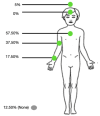Challenging Behaviors in Children with Nonverbal Autism: A Questionnaire to Guide the Design of a Wearable Device for Biomarker Recording
- PMID: 40218521
- PMCID: PMC11990949
- DOI: 10.3390/s25072009
Challenging Behaviors in Children with Nonverbal Autism: A Questionnaire to Guide the Design of a Wearable Device for Biomarker Recording
Abstract
Children with non- or minimally verbal autism (nmvASD) commonly display sensory and emotional dysregulations leading to extremely stressful situations that trigger challenging behaviors which are often difficult to treat. Nonetheless, this population remains rarely studied in clinical research. Recent methods use electrophysiological biomarkers as diagnostic tools to detect stress signals, which may be useful in anticipating situations or conditions leading to challenging behaviors in nmvASD. A specific questionnaire was created in order to identify the characteristics of nmvASD children and gather the opinions of future users (parents and caregivers) on the design of a wearable device able to collect stress-related electrophysiological data. The results indicate that approximately 67.5% of respondents (n = 40) would be interested in such a device, both in outpatient and inpatient settings. In 70% of cases, prolonged contact with an object on the trunk is always well accepted by the child. This location was also preferentially chosen by 57.5% of respondents for such a wearable device. The presence of wires could be problematic in 82.5% of cases. About 65% of respondents find it far better to integrate these wearable devices directly into the clothing. These results will help in the development of devices specifically developed for the nmvASD population to enhance their care for behavioral disorders and based on user-center design.
Keywords: behavioral disorder; electrophysiological biosignals; non or minimally verbal ASD; severe language impairment; stress; wearable device.
Conflict of interest statement
The authors declare no conflicts of interest.
Figures
Similar articles
-
Wearable Biosensing to Predict Imminent Aggressive Behavior in Psychiatric Inpatient Youths With Autism.JAMA Netw Open. 2023 Dec 1;6(12):e2348898. doi: 10.1001/jamanetworkopen.2023.48898. JAMA Netw Open. 2023. PMID: 38127348 Free PMC article.
-
Communication interventions for autism spectrum disorder in minimally verbal children.Cochrane Database Syst Rev. 2018 Nov 5;11(11):CD012324. doi: 10.1002/14651858.CD012324.pub2. Cochrane Database Syst Rev. 2018. PMID: 30395694 Free PMC article.
-
Wearable EEG Neurofeedback Based-on Machine Learning Algorithms for Children with Autism: A Randomized, Placebo-controlled Study.Curr Med Sci. 2024 Dec;44(6):1141-1147. doi: 10.1007/s11596-024-2938-3. Epub 2024 Nov 20. Curr Med Sci. 2024. PMID: 39565505 Clinical Trial.
-
Clinician perceptions of a novel wearable robotic hand orthosis for post-stroke hemiparesis.Disabil Rehabil. 2025 Mar;47(6):1577-1586. doi: 10.1080/09638288.2024.2375056. Epub 2024 Jul 8. Disabil Rehabil. 2025. PMID: 38975689
-
A Review of Wearable Solutions for Physiological and Emotional Monitoring for Use by People with Autism Spectrum Disorder and Their Caregivers.Sensors (Basel). 2018 Dec 4;18(12):4271. doi: 10.3390/s18124271. Sensors (Basel). 2018. PMID: 30518133 Free PMC article. Review.
References
-
- American Psychiatric Association, editor. Diagnostic and Statistical Manual of Mental Disorders. 5th ed. American Psychiatric Publishing; Washington, DC, USA: 2022. Text Revision.
-
- Fombonne E. Editorial: Is Autism Overdiagnosed? J. Child Psychol. Psychiatry. 2023;64:711–714. - PubMed
-
- Lundström S., Taylor M., Larsson H., Lichtenstein P., Kuja-Halkola R., Gillberg C. Perceived Child Impairment and the ‘Autism Epidemic’. J. Child Psychol. Psychiatry. 2021;63:591–598. - PubMed
MeSH terms
Substances
Grants and funding
LinkOut - more resources
Full Text Sources


